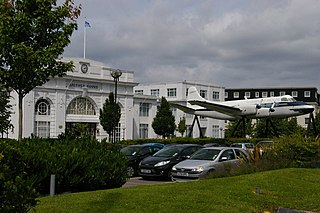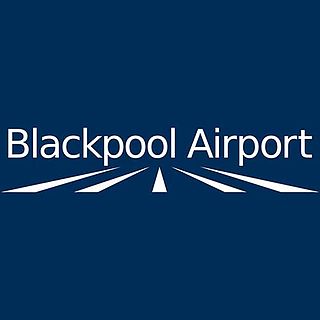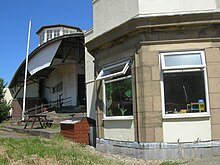
Croydon Airport was the UK's only international airport during the interwar period. Located in Croydon, Surrey, England, it opened in 1920, built in a Neoclassical style, and was developed as Britain's main airport, handling more cargo, mail, and passengers than any other UK airport at the time. Innovations at the site included the world's first air traffic control and the first airport terminal. During World War II the airport was named RAF Croydon as its role changed to that of a fighter airfield during the Battle of Britain; and in 1943 RAF Transport Command was founded at the site, which used the airport to transport thousands of troops into and out of Europe.

British Airways Ltd was a British airline company operating in Europe in the period 1935–1939. It was formed in 1935 by the merger of Spartan Air Lines Ltd, United Airways Ltd, and Hillman's Airways. Its corporate emblem was a winged lion.

Blackpool Airport is an airport on the Fylde coast of Lancashire, England, in the Borough of Fylde, just outside the Borough of Blackpool. It was formerly known as Squires Gate Airport and Blackpool International Airport.

Isle of Man Airport is the main civilian airport on the Isle of Man. It is located in the south of the island at Ronaldsway near Castletown, 6 nautical miles southwest of Douglas, the island's capital. Along with the Isle of Man Sea Terminal, it is one of the two main gateways to the island. The airport has scheduled services to the United Kingdom and the Republic of Ireland.

City Airport is an airport in Barton-upon-Irwell, Greater Manchester, England, 5 nautical miles west of Manchester. Formerly known as Barton Aerodrome and City Airport Manchester, It is known by the Civil Aviation Authority (CAA) as Manchester/Barton.

The de Havilland DH.84 Dragon is a successful small commercial aircraft that was designed and built by the de Havilland company.

Land's End Airport, situated near St Just in Penwith, 5 NM west of Penzance, in Cornwall, is the most south westerly airport of mainland Britain. The airport is owned by the Isles of Scilly Steamship Company (ISSC). ISSC's subsidiary Land's End Airport Limited operates the airport, and another subsidiary, Isles of Scilly Skybus, operates a regular passenger service to St Mary's in the Isles of Scilly as well as scenic flights around west Penwith.
Railway Air Services (RAS) was a British airline formed in March 1934 by four railway companies and Imperial Airways. The airline was a domestic airline operating routes within the United Kingdom linking up with Imperial's services.

Heston Aerodrome was an airfield located to the west of London, England, operational between 1929 and 1947. It was situated on the border of the Heston and Cranford areas of Hounslow, Middlesex. In September 1938, the British Prime Minister, Neville Chamberlain, flew from Heston to Germany three times in two weeks for talks with Adolf Hitler, and returned to Heston from the Munich Conference with the paper referred to in his later "Peace for our time" speech from 10 Downing Street.

Alexandra Park Aerodrome was the second purpose-built aerodrome in the Manchester area in England. The site was chosen by the War Department in 1917 because of its open agricultural nature, and lay between the neighbouring districts of Fallowfield, Chorlton-cum-Hardy, Whalley Range, Withington and West Didsbury, at the junction of Princess Road and Mauldeth Road West, three miles south of Manchester's city centre: the land was owned by the Egerton Estate. The aerodrome's brief existence is commemorated on a plaque in the sports pavilion at Hough End Playing Fields, which now occupy part of the site. A commemorative plaque was unveiled on 7 July 2007 to mark the 90th anniversary of the aerodrome and is located in the grounds of No. 184 Squadron, Air Cadets, in Hough End Crescent.

Hall Caine Airport, also known as Jurby Airfield, was an airfield on the Isle of Man near Ramsey. It was named after the author Sir Thomas Henry Hall Caine CH, KBE by his sons Gordon Hall Caine and Derwent Hall Caine, who began the project, and was the first airport in the British Isles to be named after a person. From 1935 to 1937 it handled domestic scheduled passenger flights to English, Scottish and Irish airports. By 1937 it had fallen into disuse, primarily due to its location.

Salisbury Woodland Gardens is an open space located in the east of Blackpool, flanked by East Park Drive and Woodside Drive and linking Blackpool Zoo with Stanley Park. Known simply as the 'Woodland Gardens' to local people, the site was acquired in 1924 by Blackpool Corporation and was originally developed as a shelter belt for the adjacent Stanley Park Golf Course. The gardens were later developed in the 1940s as an arboretum and public open space for all to enjoy. It was renovated in 1967 by Peter Perry and his 'Flying Squad. Popular once as a wedding photograph location, the site went into decline during the 1990s. The council's Ranger Service manage and protect the gardens which they took over in September 2006 and have been funding and undertaking the restoration of the woodland. In 1967, Parks Director Norman Leach appointed gardener Pete Perry and his Flying Squad of gardeners to plant up the gardens. All plants, were grown from seed in the greenhouses at Stanley Park, and planted en masse. Extra shrubs, including azalea were also planted.

Isle of Man Air Services Ltd (IoMAS) was a small airline, based at Ronaldsway Airport Isle of Man, which operated scheduled flights to the English and Scottish mainland between formation in September 1937 and nationalisation in January 1947.
United Airways Ltd was a British airline operating in 1935, ending as part of British Airways Ltd.
Spartan Air Lines Ltd was a British private airline company, in the period 1933–1935. In 1933, it started operating passenger services from the London area to the Isle of Wight. In late 1935 it merged with United Airways Ltd to form British Airways Ltd.
Allied Airways was a UK airline based at Aberdeen, Scotland. Formed in 1934 as Aberdeen Airways it was taken over by British European Airways in 1947.
Northern & Scottish Airways was a regional airline established in Glasgow in 1934. It was taken over in 1937, eventually becoming part of British European Airways.
Midland & Scottish Air Ferries was Scotland's first airline, operating from 1933 to 1934. It is particularly noted for pioneering flights to the Inner Hebrides

Lancashire Aircraft Corporation was a major British charter airline after World War II. Its founding father was Eric Rylands. It played an important role in the Berlin Airlift. It also flew scheduled routes and was important in the development of Coach-air services, leading to the founding of Skyways Coach Air and the start of the Inclusive Tour (IT) industry. Its major subsidiary, Samlesbury Engineering, supported its operations and converted many military aircraft for commercial use, also founding Lancashire Aircraft Company.
Cramlington Aerodrome was a military airfield established in Northumberland during the First World War. It became a civil airfield serving the Tyneside area of north-east England and operated until 1935, when it was replaced by Woolsington Airport, now known as Newcastle International Airport.

















